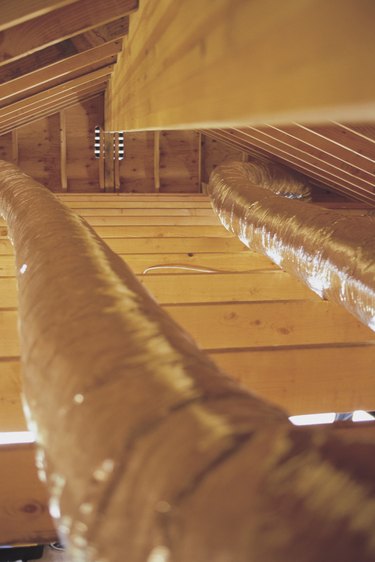 Seal and insulate all air ducts for maximum energy efficiency. Image Credit: Comstock/Comstock/Getty Images
Seal and insulate all air ducts for maximum energy efficiency. Image Credit: Comstock/Comstock/Getty Images
Air ducts are part of a forced air furnace or an HVAC (heating, ventilation, air conditioning) system. The ducts connect to the furnace blower motor and the motor distributes either heated or cooled air throughout the home. Properly sealed and insulated ducts make the system highly efficient, but if there are even minor leaks along the ductwork, your energy consumption and the costs associated with it will increase proportionately, depending upon how bad the ducts are leaking.
Video of the Day
The Filter Box
The first place to begin is at the filter box. This is the container that holds the furnace or HVAC filter. Depending on what type of filter you have, whether it is a common mesh filter or a highly efficient electrostatic-type filter, the filter box holds it in place. Check all seams around the filter box, and if there is a door where the filter is inserted, make sure it closes tightly and is not impeded by dust or dirt particles. Make sure the filter is the correct size and fits tightly. A wrong sized or smaller filter diminishes overall air quality. Any leaking here blows air past the filter, and minimizes its properties, discharging unfiltered air directly into the room where the system is located.
Duct Runs
Duct runs snake through basements, crawlspaces, attics or a combination of any or all three. The joints where the ducts connect are the most common places for holes in the air ducts to occur. If there is no tape or insulation around the joints, the ducts are leaking. Check for duct hangers that are not intact. Sagging ducts may pull apart and cause holes in the air duct system if they are not properly secured.
Registers
Where the air ducts meet the registers is another common place for holes and leaks. Opening and closing of the vents cause vibrations that may loosen unsealed ducts. Gaps or holes between the ducts and the registers allow air to leak out. Leaks here may alter the performance of the heating and cooling system supplying the room. A room with a leaky duct at the register may not heat up or cool down properly. Compensation may mean turning the heat or the air conditioner on for longer periods, overheating or overcooling the rest of the home just to make the affected room comfortable.
Seal and Insulate
Prevent holes and leaks by sealing all of the joints along the air ducts. Positively attach all ducts together with sheet-metal screws, if they are metal. Tape all of the joints, on both metal and nonmetal ductwork with aluminum duct tape. Do not use standard rubber-backed adhesive duct tape because the adhesive will dry up and the tape will fail. Wrap duct insulation around the ducts and seal it with aluminum duct tape. Ensure all hangers are properly in place, and use more hangers to secure ductwork that is sagging.


